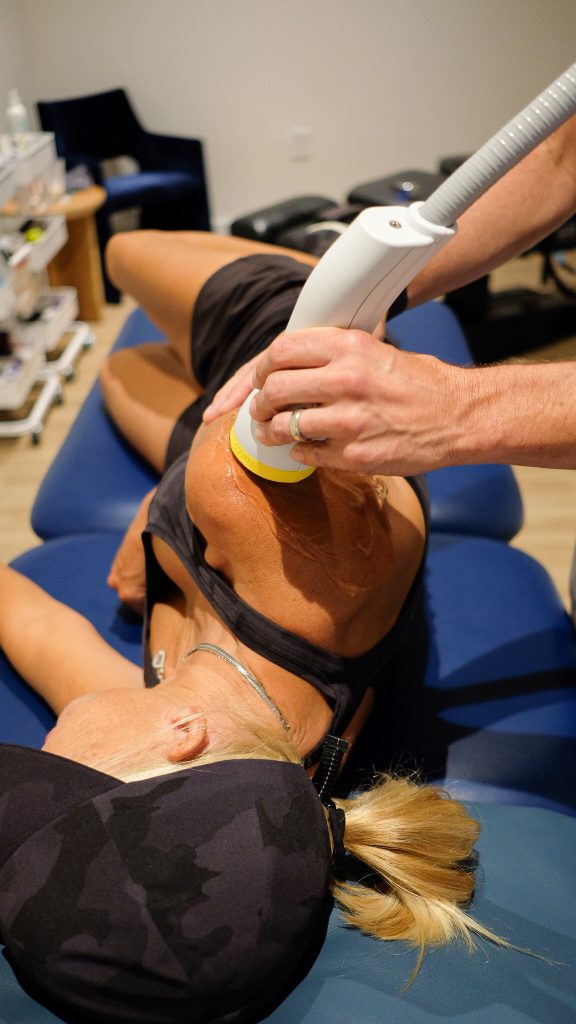SoftWave Therapy is a regenerative treatment that uses unfocused shockwaves to stimulate your body’s natural healing response—without needles, drugs, or surgery. It’s non-invasive, well-tolerated, and especially effective for active individuals looking to recover faster from injuries or reduce chronic pain without interrupting their training routine.
What makes SoftWave different from other treatments is its depth of tissue impact and biological activation. The acoustic waves penetrate deep into injured or inflamed tissue, triggering a cascade of healing responses—like increased blood flow, stem cell recruitment, and the breakdown of scar tissue.
READ: Treating Hip Overuse Injuries in Tennis with SoftWave Technology
Unlike ice, ultrasound, or electrical stimulation—which often provide only short-term relief—SoftWave is designed to repair, not just relieve. At Smart Athlete PT, we use this advanced technology to help athletes and active adults get back to doing what they love, stronger and more resilient than before.

What Conditions or Injuries SoftWave Can Help Treat
SoftWave therapy is especially effective for treating a wide range of soft tissue injuries and chronic conditions common among athletes and active adults. Whether you're recovering from overuse, a nagging injury, or just looking to stay ahead of breakdown, SoftWave can be a game-changer.
At Smart Athlete PT, we often use SoftWave to treat:
- Tendinopathies: Conditions like Achilles tendinitis, patellar tendinopathy, and tennis elbow respond well to SoftWave’s ability to stimulate tendon healing and reduce inflammation.
- Rotator Cuff and Shoulder Issues: From impingement to strain, SoftWave supports shoulder mobility and tissue repair.
- Plantar Fasciitis: A common issue for runners and court-sport athletes, SoftWave helps reduce heel pain and restore foot function.
- Chronic Joint Pain: SoftWave is an effective tool for relieving knee, hip, or back pain caused by stiffness, degeneration, or tissue restriction.
- Scar Tissue and Restricted Mobility: SoftWave can help break up fibrotic tissue and improve range of motion—especially when combined with targeted sports physical therapy.
If you're dealing with persistent pain or a slow-healing injury, this treatment can help accelerate your recovery and get you back to peak performance—without invasive procedures or prolonged rest.
Your First SoftWave Session: What to Expect
If you’ve never had SoftWave Therapy before, here’s what you can expect during your first visit at Smart Athlete PT.
READ: Tennis Elbow and SoftWave: A Modern Approach to Pain Relief
We start with a comprehensive evaluation to understand your injury, pain patterns, and movement limitations. This ensures SoftWave is being used purposefully—targeting the areas that are most in need of tissue regeneration or inflammation control.
Once your therapist identifies the treatment area, a water-based gel is applied to the skin to help transmit the acoustic waves. Then, the SoftWave applicator is moved across the surface of the skin to locate and treat painful or inflamed tissues. You may feel a mild tapping or pulsing sensation—sometimes intense in sensitive areas—but most patients describe the discomfort as manageable and brief.
Each session typically lasts about 10 to 15 minutes, and there’s no downtime required. In fact, many patients return to movement training or their daily activities right after treatment.
Our goal at Smart Athlete PT is to make the session as informative and comfortable as possible. You’ll understand what we’re treating, why it matters, and how it fits into your broader recovery plan.
How We Combine SoftWave with Sports Physical Therapy
At Smart Athlete PT, SoftWave Therapy isn’t used in isolation—it’s part of a strategic, movement-based rehab program tailored to your specific goals. Our team specializes in sports physical therapy, which means we focus not just on pain relief, but on optimizing how you move, train, and perform.
We often begin by using SoftWave to reduce inflammation, stimulate healing, and release tissue restrictions. Once your pain and mobility begin to improve, we layer in targeted strength and movement training designed to correct imbalances and restore control.
This dual approach is what helps set Smart Athlete PT apart:
- SoftWave prepares the tissue by increasing circulation and stimulating repair.
- Physical therapy builds the foundation through strength, mobility, and neuromuscular re-education.
READ: Self-Assessment and Treatment of the Hip for Tennis Athletes
Whether you're recovering from a sports injury or trying to eliminate chronic pain that’s limiting your performance, the integration of these therapies ensures your treatment is both efficient and effective.
Our mission is to help you return to activity stronger than before—with fewer setbacks and long-term confidence in your body.
Real Results: What Patients Typically Experience
Most patients begin noticing improvements within the first few SoftWave sessions. For some, the initial response is reduced pain and less stiffness. For others, it’s improved range of motion, easier movement, or the ability to train without discomfort.
Because SoftWave targets the root causes of tissue dysfunction—like inflammation, poor circulation, or scar tissue buildup—its effects tend to compound over time. Combined with the strength and mobility gains from your sports physical therapy plan, the results are not only faster, but longer-lasting.
At Smart Athlete PT, we've seen athletes return to sport sooner, avoid unnecessary surgeries, and build greater resilience through this integrated model. Whether you're a runner with chronic Achilles tightness or a tennis player struggling with shoulder pain, SoftWave therapy gives your body the boost it needs to heal—and the support it needs to stay strong.
You won’t just feel better. You’ll move better.
